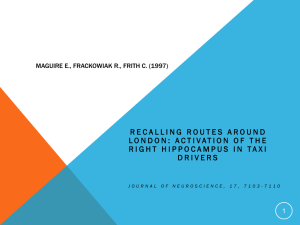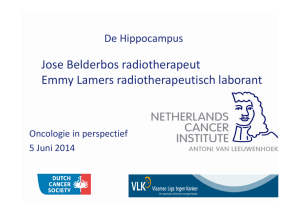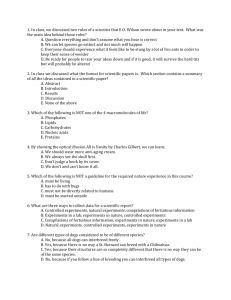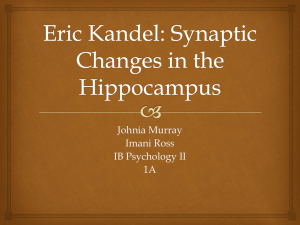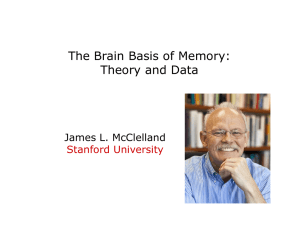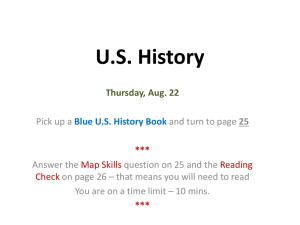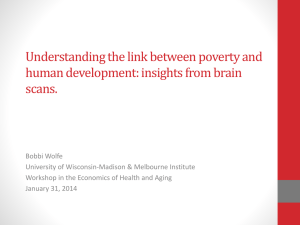ANTSMethodologySummary
advertisement
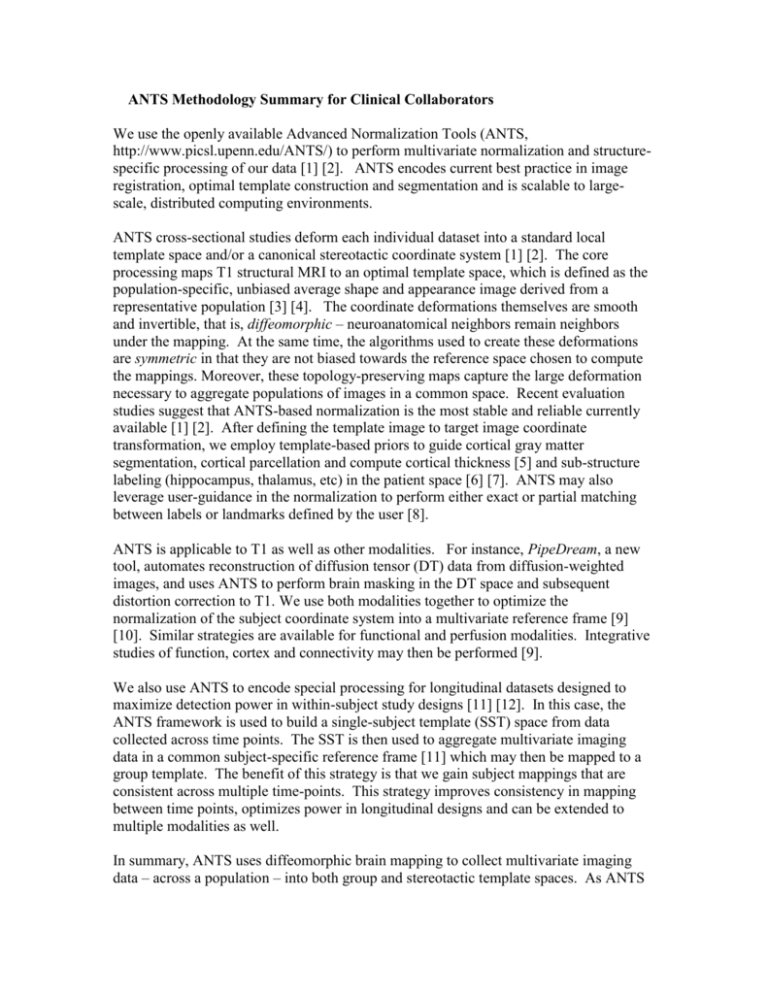
ANTS Methodology Summary for Clinical Collaborators We use the openly available Advanced Normalization Tools (ANTS, http://www.picsl.upenn.edu/ANTS/) to perform multivariate normalization and structurespecific processing of our data [1] [2]. ANTS encodes current best practice in image registration, optimal template construction and segmentation and is scalable to largescale, distributed computing environments. ANTS cross-sectional studies deform each individual dataset into a standard local template space and/or a canonical stereotactic coordinate system [1] [2]. The core processing maps T1 structural MRI to an optimal template space, which is defined as the population-specific, unbiased average shape and appearance image derived from a representative population [3] [4]. The coordinate deformations themselves are smooth and invertible, that is, diffeomorphic – neuroanatomical neighbors remain neighbors under the mapping. At the same time, the algorithms used to create these deformations are symmetric in that they are not biased towards the reference space chosen to compute the mappings. Moreover, these topology-preserving maps capture the large deformation necessary to aggregate populations of images in a common space. Recent evaluation studies suggest that ANTS-based normalization is the most stable and reliable currently available [1] [2]. After defining the template image to target image coordinate transformation, we employ template-based priors to guide cortical gray matter segmentation, cortical parcellation and compute cortical thickness [5] and sub-structure labeling (hippocampus, thalamus, etc) in the patient space [6] [7]. ANTS may also leverage user-guidance in the normalization to perform either exact or partial matching between labels or landmarks defined by the user [8]. ANTS is applicable to T1 as well as other modalities. For instance, PipeDream, a new tool, automates reconstruction of diffusion tensor (DT) data from diffusion-weighted images, and uses ANTS to perform brain masking in the DT space and subsequent distortion correction to T1. We use both modalities together to optimize the normalization of the subject coordinate system into a multivariate reference frame [9] [10]. Similar strategies are available for functional and perfusion modalities. Integrative studies of function, cortex and connectivity may then be performed [9]. We also use ANTS to encode special processing for longitudinal datasets designed to maximize detection power in within-subject study designs [11] [12]. In this case, the ANTS framework is used to build a single-subject template (SST) space from data collected across time points. The SST is then used to aggregate multivariate imaging data in a common subject-specific reference frame [11] which may then be mapped to a group template. The benefit of this strategy is that we gain subject mappings that are consistent across multiple time-points. This strategy improves consistency in mapping between time points, optimizes power in longitudinal designs and can be extended to multiple modalities as well. In summary, ANTS uses diffeomorphic brain mapping to collect multivariate imaging data – across a population – into both group and stereotactic template spaces. As ANTS may be used to reconstruct gray matter, cortical thickness and diffusion tensor related variables, such as the fractional anisotropy, we are able to perform both traditional Jacobian-based morphometry studies and studies that use descriptors of optimal power for both cortex (gray matter probability, cortical thickness) and white matter (DTI). ANTS also provides prior predictions in subject space of the location of cortex, hippocampi and other deep brain structures. Finally, ANTS easily adapts cross-sectional methodology for optimal longitudinal-specific processing protocols. REFERENCES Evaluation and Normalization [1] Avants, B. B.; Epstein, C. L.; Grossman, M. & Gee, J. C. Symmetric diffeomorphic image registration with cross-correlation: Evaluating automated labeling of elderly and neurodegenerative brain. Med Image Anal, Department of Radiology, University of Pennsylvania, 3600 Market Street, Philadelphia, PA 19104, United States., 2008, 12, 26-41 [2] Klein, A.; Andersson, J.; Ardekani, B. A.; Ashburner, J.; Avants, B.; Chiang, M.; Christensen, G. E.; Collins, L.; Hellier, P.; Song, J. H.; Jenkinson, M.; Lepage, C.; Rueckert, D.; Thompson, P.; Vercauteren, T.; Woods, R. P.; Mann, J. J. & Parsey, R. V. Evaluation of 14 nonlinear deformation algorithms applied to human brain MRI registration. Neuroimage, New York State Psychiatric Institute, Columbia University, NY, NY 10032, USA., 2009 Optimal Templates [3] Avants, B. & Gee, J. Geodesic estimation for large deformation anatomical shape and intensity averaging Neuroimage, 2004, Suppl. 1, S139-150 [4] Avants, B. B.; Yushkevich, P.; Pluta, J.; Minkoff, D.; Korczykowski, M.; Detre, J. & Gee, J. C. The optimal template effect in hippocampus studies of diseased populations. Neuroimage, 2010, 49, 2457-2466 Cortical Thickness [5] Das, S. R.; Avants, B. B.; Grossman, M. & Gee, J. C. Registration based cortical thickness measurement. Neuroimage, Department of Radiology, University of Pennsylvania School of Medicine, Philadelphia, PA, USA. 2009, 45, 867-879 Structure specific analysis [6] Avants, B. B.; Hurt, H.; Giannetta, J. M.; Epstein, C. L.; Shera, D. M.; Rao, H.; Wang, J. & Gee, J. C. Effects of heavy in utero cocaine exposure on adolescent caudate morphology. Pediatr Neurol, Department of Radiology, University of Pennsylvania, Philadelphia, Pennsylvania 19104, USA. 2007, 37, 275-279 [7] Pluta, J.; Avants, B.; Yushkevich, P.; Glynn, S.; Awate, S.; Detre, J.; Mechanic, D. & Gee, J. C. Expectation matching for incomplete label driven semi-automated hippocampus segmentation in epilepsy Hippocampus, 2009, accepted [8] Yushkevich, P. A.; Avants, B. B.; Pluta, J.; Das, S.; Minkoff, D.; Mechanic-Hamilton, D.; Glynn, S.; Pickup, S.; Liu, W.; Gee, J. C.; Grossman, M. & Detre, J. A. A high-resolution computational atlas of the human hippocampus from postmortem magnetic resonance imaging at 9.4 T. Neuroimage, Penn Image Computing and Science Laboratory (PICSL), Department of Radiology, University of Pennsylvania, Philadelphia, PA 19104, USA, 2009, 44, 385-398 Longitudinal Analysis [9] Avants, B.; Grossman, M. & Gee, J. C. The correlation of cognitive decline with frontotemporal dementia induced annualized gray matter loss using diffeomorphic morphometry. Alzheimer Dis Assoc Disord, University of Pennsylvania School of Medicine, Philadelphia, 19104-6389, USA. avants@grasp.cis.upenn.edu, 2005, 19 Suppl 1, S25-S28 [10] Avants, B.; Khan, A.; McCluskey, L.; Elman, L. & Grossman, M. Longitudinal cortical atrophy in amyotrophic lateral sclerosis with frontotemporal dementia. Arch Neurol, 2009, 66, 138-139 Diffusion Tensor Image Analysis [11] Avants, B.; Duda, J. T.; Kim, J.; Zhang, H.; Pluta, J.; Gee, J. C. & Whyte, J. Multivariate analysis of structural and diffusion imaging in traumatic brain injury. Acad Radiol, Department of Radiology, University of Pennsylvania, Philadelphia, PA 19104, USA., 2008, 15, 1360-1375 [12] Zhang, H.; Avants, B. B.; Yushkevich, P. A.; Woo, J. H.; Wang, S.; McCluskey, L. F.; Elman, L. B.; Melhem, E. R. & Gee, J. C. High-dimensional spatial normalization of diffusion tensor images improves the detection of white matter differences: an example study using amyotrophic lateral sclerosis. IEEE Trans Med Imaging, Penn Image Computing and Science Laboratory, University of Pennsylvania, Philadelphia, PA 19104, USA., 2007, 26, 1585-1597 [13] Avants, B. B.; Cook, P. A.; Ungar, L.; Gee, J. C. & Grossman, M. Dementia induces correlated reductions in white matter integrity and cortical thickness: a multivariate neuroimaging study with sparse canonical correlation analysis. Neuroimage, Department of Radiology, University of Pennsylvania, Philadelphia, PA 19104-6389, USA. avants@grasp.cis.upenn.edu, 2010, 50, 1004-1016 XXXXXXXXXXXXXXXXXXXXXXXXXXXXXXXXXXXXXXXXXXXXXXXXX Hippocampus Segmentation XXXXXXXXXXXXXXXXXXXXXXXXXXXXXXXXXXXXXXXXXXXXXXXXX The hippocampus is a challenging and time consuming structure to manually segment even with tools such as ITK-SNAP [1]. Expert neuroanatomists trained with welldefined protocols are unable to provide perfectly reproducible labelings of the hippocampus or hippocampus-amygdala complex [2]. Fully automated methods, such as template and normalization based mapping [3] [4] [5], increase the reproducibility of hippocampus segmentation. Reliability suffers, however, when these methods are applied to populations with severe atrophy or other structural abnormalities [6]. This unpredictability makes fully automated approaches unlikely to be used in clinical protocols. One solution to this problem synthesizes manual effort with automated tools to maximize the benefit of user input and, at the same time, minimize the human effort required [7]. We recently developed a fast, well-defined, template-based landmarking protocol that requires only six landmarks per hippocampus placed on only three slices of the individual brain. This protocol takes approximately one minute per hippocampus and leverages the interface available in ITK-SNAP [1] for landmark placement. It is currently being evaluated by a team of neuroanatomists at the University of Pennsylvania Department of Neurology with encouraging preliminary results that indicate ease of use and reliability and quality of performance. We illustrate the results of this approach for labeling a sclerotic hippocampus in Figure 1 below. Fig. 1. The hippocampus was labeled with a symmetric diffeomorphic normalization method that uses a combination of landmark and image similarity in a rapid and reliable hippocampus segmentation protocol. The semi-automated approach took approximately one minute of user-time per hippocampus. Our workflow is able to propagate segmentations or parcellations generated on custom templates [OptimalTemplateRefs] by local neuroanatomists or, alternatively, use openaccess labeled templates as available in the adult MNI [m] and IBSR [i] datasets or the pediatric CCHMC template [c]. The workflow combines linear registration to a standard space, landmark placement in this standard space via ITK-SNAP and, finally, nonlinear deformation with landmark-assisted diffeomorphic normalization. The first step of the process involves automated affine normalization of the full dataset to the selected template. This preprocessing allows the workflow to take advantage of consistently oriented data. The second step is for the user to place approximate, sparsely separated landmark regions on the anatomy of interest. For instance, in our hippocampus segmentation protocol, these landmark regions are given as three-dimensional spheres, of radius 1.5 mm, through the ITK-SNAP interface. Only six per hippocampus are required on only three slices of the re-oriented neuroanatomy. The standard approach is to place the first landmark on the most lateral sagittal slice of the hippocampus. The second series of landmarks are placed at anterior and posterior ends of the hippocampus on a slice 4 mm medially from the first landmark. The final series of three landmarks is placed at the most medial slice of the mid-hippocampus body. One landmark is placed at the mid-body and the other two are placed at the posterior and anterior end of the hippocampus, in this slice. A key benefit of this approach is that the landmarks are used only for coarse anatomical alignment. Fine structural alignment is guided by a combination of both image and landmark features. A second benefit is that these landmarks are not dirac-delta functions, or isolated points. Instead, they are treated as probability distributions that are defined within the labeled region, yielding a smoother landmark effect on the transformation. Finally, while the above protocol uses spherical regions, a natural and direct extension of this approach would be to label sulci or curves interactively with ITK-SNAP's drawing tools and/or to mask the labeled regions with tissue-class probabilities. Both of these extensions involve no additional code but instead just simple adjustments to labeling protocol. Thus, the protocol gives a "best of both worlds" approach, maximizing the benefit of both user-interaction and automation and is flexible enough to apply to hippocampal segmentation, sulcal labeling or segmentation of deep brain structures. [1] Yushkevich PA, Piven J, Hazlett HC, Smith RG, Ho S, Gee JC, Gerig G. 2006. User-guided 3D active contour segmentation of anatomical structures: Significantly improved efficiency and reliability. Neuroimage, 31(3):1116-28. [2] Bonilha, L., Kobayashi, E., Cendes, F., Li, L.M. 2004. Protocol for Volumetric Segmentation of Medial Temporal Structures Using High-Resolution 3-D Magnetic Resonance Imaging. Human Brain Mapping, 22: 145-154. [3] Crum, W.R., Scahill, R.I., Fox, N.C. 2001. Automated Hippocampal Segmentation by Regional Fluid Registration of Serial MRI: Validation and Application in Alzheimer’s Disease. NeuroImage, 13: 847-855. [4] Avants, B.; Grossman, M. & Gee, J. C. Symmetric Diffeomorphic Image Registration: Evaluating Automated Labeling of Elderly and Neurodegenerative Cortex Medical Image Analysis, 2007 [5] Csernansky, J.G., Joshi, S., Wang., L., Haller, J.W., Gado, M., Miller, J.P., Grenander, U., Miller, M.I. 1998. Hippocampal morphometry in schizophrenia by high dimensional brain mapping. Proceedings of the National Academy of Sciences of the United States of America, 95 (19): 11406-11411. [6] Hogan, R.E., Mark, K.E., Wang, L., Joshi, S., Miller, M.I., Bucholz, R.D. 2000. Mesial Temporal Sclerosis and Termporal Lobe Epilepsy: MR Imaging Deformation-based Segmentation of the Hippocampus in Five Patients. Radiology, 216: 291-297. [7] Avants, B. B., Schoenemann, P.T., Gee, J.C., 2006. Landmark and Intensity Driven Lagrangian Frame Diffeomorphic Image Registration: Application to Functionally and Structurally-based Inter-Species Comparison, Medical Image Analysis v. 10(3):397-412.

